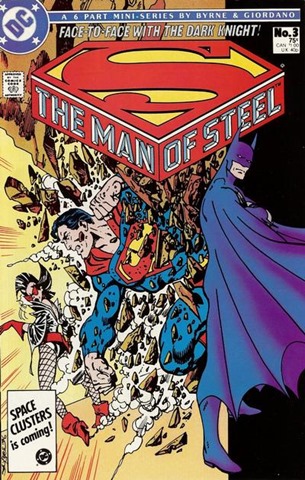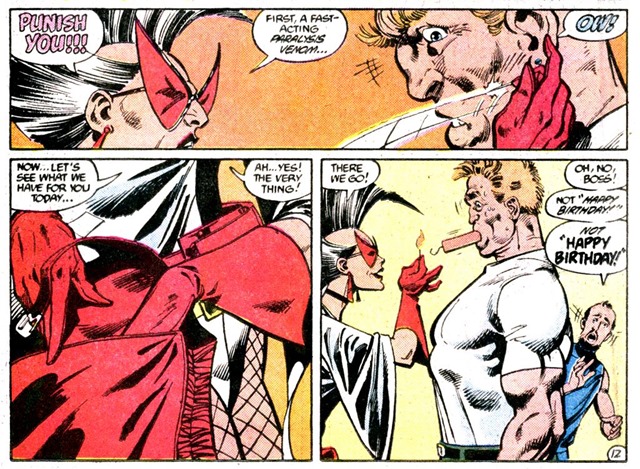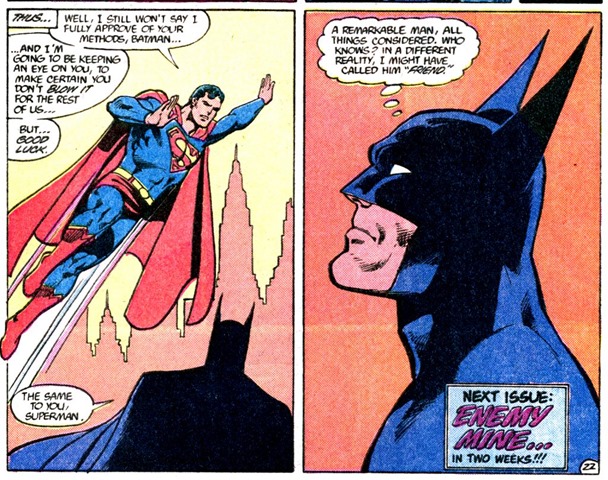Look! Up in the sky! It’s a bird! It’s a plane! It’s…Batman?
In his third issue of the retelling of Superman’s early years, Byrne reunites the World’s Finest team for the first time, as the Action Ace meets the Dark Knight.
 |
| Now I'm curious as to what "Space Clusters" was. |
The Man of Steel, “One Night in Gotham City…”
Written by John Byrne
Art and Cover by John Byrne and Dick Giordano
Edited by Andy Helfer
As with last issue, there isn’t actually a whole lot of story to recap here, as the actual plot wasn’t really the point. Instead, Byrne wanted to explore the interpersonal dynamic between DC’s biggest two biggest heroes in the context of the new, post-Crisis status quo.
That’s really the point of the entire mini-series, actually – not the examination of interpersonal dynamics, but rather the establishment of the new status quo.
In creating his vision of Superman, Byrne did a lot of picking and choosing from he history of the 49+ years that had preceded his work, keeping some elements of the old relatively unchanged, making major changes to some others, and completely abandoning still others.
That actually requires covering a lot ground – particularly as it lays the foundation for the upcoming monthly books – and even with as exposition-heavy as Byrne’s work is, with only two issues under our belt, there remains a lot we don’t know.
Given that the relationship between Superman and Batman had an extensive history, it made a lot of sense to have “How does the new Superman get along with Batman?” the question to answer immediately after establishing Superman’s place in the world.
This is especially true given that prior to Crisis the Superman/Batman dynamic had undergone a significant shift. For decades, Superman and Batman were besties, starring together in a long-running comic entitled World’s Finest.
However, at some point in the mid-80s – I don’t recall what led to the split – tensions eventually erupted that brought about the end of their storied friendship, leading to the two heroes merely tolerating each other.
So, in this new world, what would we see? Friendship? Civil professional respect? Outright hostility?
Honestly, I think everyone would have agreed that we’d be happy with anything other than this. (#8)
In any case, on to the relatively thin story, which opens in Gotham where we find Batman doing what Batman does: beating the shit out of someone.
There are a few things we learn from this quick beatdown. For one thing, it’s very early in Batman’s caped crusading career, as evidenced by the fact that the bat insignia on his chest is not inside of a yellow oval, which for comic book readers is shorthand for “Batman is just starting out.”
We also learn that Batman is on the trail of someone – a woman – who has murdered eight people and that the thug getting the beating works for this mysterious woman. However, while the thug – a man named Bull – is naturally afraid of Batman, he is, remarkably, even more afraid of his mysterious employer. After desperately tossing a clump of garbage in Batman’s face, Bull makes a break for it, and Batman sets off in pursuit via a batline, and because it’s a comic book written by Byrne, as he does so he makes certain to talk – out loud – about his motivations and his need to keep the scum of Gotham afraid of him. However, his pursuit comes to an abrupt end as he finds that something has grabbed hold of his line and is pulling him upward. That something turns out to be a someone: Superman.
As mentioned, this is early in Batman’s career, which means that he doesn’t have a friend in the GCPD in the form of Commissioner Gordon yet and his unsanctioned vigilante activities have made him a wanted criminal. Superman, it seems, has decided that Batman is giving costumed heroes a bad name and has headed over to Gotham to take Batman down.
Because he’s the goddamn Batman, he managed to slip out of Superman’s grasp and sight, and after taking a moment to gloat about Superman’s confusion over someone manage to escape from his sight, he he reappears out of the shadows. Superman moves to take him in, but before he can do so, Batman tells him to check out the electromagnetic field that’s surrounding him, one which is keyed to detect contact with super-dense organic material – AKA Superman’s meat hooks – and that if the field is broken a bomb will go off somewhere in Gotham, killing an innocent person. Batman, after all, being the goddamn Batman, has anticipated that this confrontation would eventually take place.
Though Superman is appalled, he’s willing to listen as Batman makes his pitch. There’s a woman calling herself Magpie who’s been robbing museums and jewelry stores and whatnot, replacing the priceless objects she’s taken with deadly trinkets that have left more than a half a dozen people dead. Batman pledges to willingly turn himself in if Superman helps him take down Magpie.
And eventually they do. It’s all kind of boring, frankly. Magpie isn’t exactly one of the most memorable members of Batman’s Rogues Gallery, despite the psychotic quirkiness that Byrne tries to infuse into her, such as in this scene – in which Byrne, in classic Byrne fashion, throws in a reference to something he likes – which shows us why Bull was more afraid of Magpie than Batman:
 |
| The only interesting thing that Magpie ever did. |
The reference, for those of you who don’t know, is to a classic Looney Tunes moment:
Anyway, they catch her, she gets hauled off to jail, and Superman decides that even though he doesn’t approve of Batman’s methods, he recognizes that they’re both on the same side and that Gotham is different enough from Metropolis that keeping it safe requires different methods, so he has no interest in taking him in. However, there is still the matter of the bomb.
At that point, Batman reveals that he would never put someone else’s life in jeopardy and that the bomb was on him the whole time. Batman himself was the innocent person who would have blowed up if Superman had tried to get all handsy.
While it was a dangerous game to play, Batman figured that Superman would know whether or not he was bluffing.
And so, Superman heads back to Metropolis, and the new Batman/Superman relationship has been established. Not friend, exactly, but not entirely acrimonious either. With a final nod to what had gone before, Byrne closes with this:
 |
| Should have gone full Silver Age and had him turn to wink at the reader. |
Up Next: Enter…Lex Luthor!
Some Thoughts:
As I said, the actual story was pretty boring. Magpie is a D List villain at best, and lacking any real abilities, she wasn’t much of a challenge for our heroes. Apart from an appearance in one of Batman’s comics a few months later, I can’t recall her ever showing up again.
Under the circumstances, though, it made a certain amount of sense to use a throwaway villain, as the real focus of the story was on the interaction between the two heroes, and the conflict that results from the different methods they use to achieve the same ends.
Technically, I don’t see their methods as being that radically different. I mean, ultimately, they both resolve most problems the same way: by punching them. It’s just that Superman can punch a whole lot harder. Of course, what he lacks in brute strength, Batman makes up for in sheer brutality. Superman punches harder, but Batman punches meaner.
However, there is an inherent philosophical difference in their approaches, as Superman seeks to inspire people to be better, and nobler, and to have the courage to hope.
Batman, meanwhile, wants to inspire pants-shitting fear.
I won’t wade into the whole Superman vs. Batman thing – either in the “Who would win in a fight?” sense or the “Who is the more interesting character?” sense – as there are plenty of people who have written volumes on that subject.
I will say, though, that while a lot of people thought that it never made sense for the two of them to be friends, I kind of disagree with that assessment. At least, in terms of the reasons why they wouldn’t be friends. As I said, despite surface appearances, they really aren’t all that different. Sure, Batman is a little more – okay, a lot more – willing to viciously brutalize people, but when it comes down to it, there is a line that neither one will cross, and ultimately they’re both working towards the same goal.
Besides that, while obviously the brutal murder of his parents is what drove Bruce Wayne to become Batman, the one thing that often gets overlooked is that, like Clark, Bruce had loving parents who worked very hard to raise him properly and instill strong values in him. It’s that influence that prevents Batman from crossing the line into full-on vigilante territory. Honestly, had Thomas and Martha Wayne lived, I think Bruce would have grown up to be a man who wasn’t all that different from Clark.
Then again, there is the question of how much a rich kid and a farm boy would really have in common apart from their propensity to wear tights and capes, put their underwear on over their pants, and punch out criminals.
In the end, I think the question of “Would they be friends?” can go either way, and given the tendency for DC to shake up their history on a semi-regular basis, there are a lot of opportunities to provide different answers to that question.
It’s worth noting that shortly after The Man of Steel, Batman got his own revamped post-Crisis origin story in the form of Batman: Year One, the seminal work by Frank Miller and David Mazzuchelli, which is probably my favorite Batman story ever. Year One demonstrates why, despite the fact that his mind hasn’t exactly been in mint condition for a long, long time, there was a time when Frank Miller was arguably one of the finest talents working in comics and still manages to get work.
While being a groundbreaking work, Year One didn’t represent as much of a seismic shift to the Batman mythos as TMoS did for Superman, and it was much more of a soft reboot that ran as a storyline in the regular run of Batman.
I mentioned that, as with the Looney Tunes bit, Byrne liked to throw in references to other works. It was something he continued to do once his regular run began, with frequent Monty Python references, and little “Easter Eggs” like a couple of British Intelligence agents who were very clearly modeled on Steed and Peel.
Finally, one other item of note from this issue is that we learn that, unlike his pre-Crisis version, this version of Superman actually needs to breathe.
The Art:
I actually like Byrne’s take on Batman, as it seems to marry elements of the style of such classic and definitive Bat-artists as Neal Adams, Marshall Rogers, and Jim Aparo, while still being very much in Byrne’s distinctive style.
That said, I don’t think it really suits the Batman of this particular era, as the early Batman was a lot less slick and polished.
But if that’s the only complaint I have about the art – and it is – then we’re in pretty good shape in that department.
For what it’s worth, in terms of the look Byrne’s Superman is my favorite Superman, and I wish that it was what I pictured when I think “Superman,” but, thanks to his decades of providing the definitive version, I always see Curt Swan’s Superman.
Overall, setting aside the Looney Tunes reference, the only thing that was interesting about Magpie was her look, but in terms of her look…Holy 1980s, Batman! It was not exactly something that you would call timeless.
I’m too lazy to look to see whatever happened to her, if anything, but I kind of hope that she popped up in an issue of Suicide Squad at some point and was the member of a mission that didn’t make it back home.
2 comments:
Here ya go:
Magpie was a former jewel thief and member of Penguin's gang. She has returned as a Black Lantern.
http://www.comicvine.com/magpie/4005-20999/
Lazy bastid
I suppose I should have stressed that in addition to not knowing whatever happened to Magpie, I also didn't care.
I still prefer to think that she died - early and painfully - in an ill-fated adventure of Task Force X.
Post a Comment